Food Enzymes Market Research, 2031
The global food enzymes market was valued at $1906.7 million in 2020, and is projected to reach $4124.7 million by 2031, growing at a CAGR of 6.2% from 2022 to 2031.
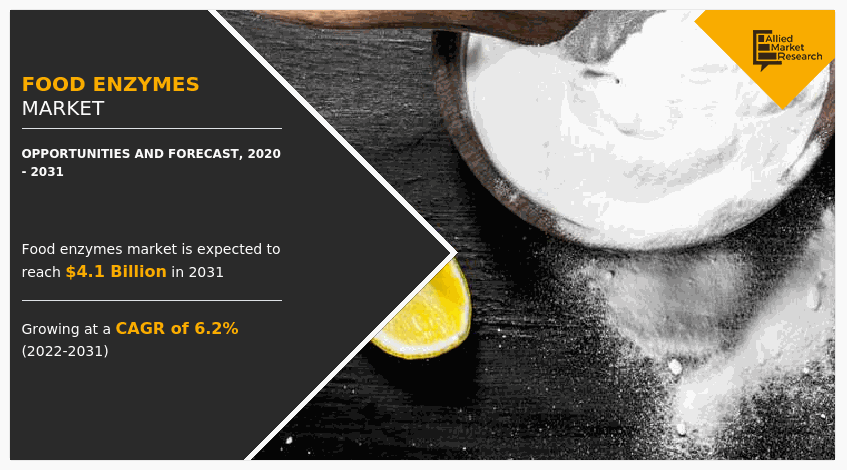
Food enzymes are complex ingredients, which act as catalyzers and are extensively used for increasing the diversity, variety, and quality during processing of food. Food enzymes are often used for food processing owing to its multiple benefits, which includes enhancement of texture, flavor & fragrance, preservation, coagulation, and tenderization. Enzymes are majorly used in the baking industry, fruit juice & cheese manufacturing, and brewing. The report focuses on the food enzymes market growth prospects, restraints, and opportunities of the global food enzymes market. The study provides Porter’s five forces analysis to understand the impact of various factors such as competitive intensity of competitors, bargaining power of suppliers, threat of substitutes, threat of new entrants, and bargaining power of buyers of the market.
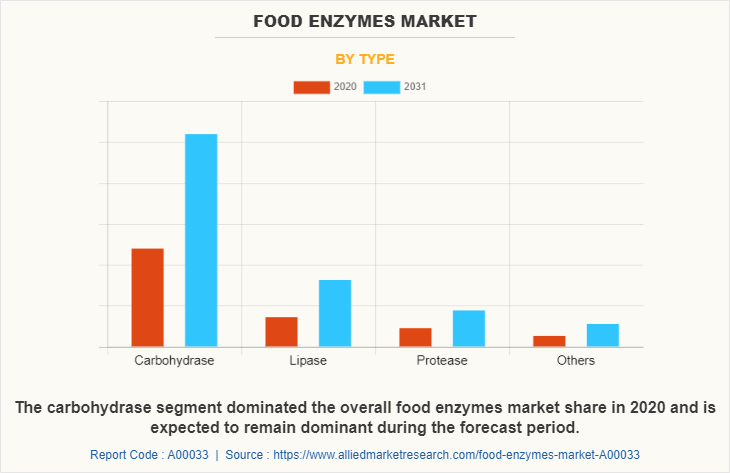
The carbohydrase segment dominated the overall food enzymes market share in 2020 and is expected to remain dominant during the food enzymes market forecast period. Carbohydrase enzyme is chiefly applicable in baking and brewing industries, as it performs function of conversion of carbohydrates into simple sugar. Amylase is a subtype of carbohydrase enzyme that has significant application in the production of bakery products. In addition, it is used in the beverage industry for beer formulation. Apart from carbohydrase, protease, and lipase find their application in the dairy sector
Increase in demand for high-quality food & beverages in terms of taste and nutritional content has been witnessed all across the globe. Consumers are shifting their preference from regular staple food to nutrient-enhanced healthy food products, thereby fostering the growing demand for enzymes in the food & beverages industry. Food enzymes play a pivotal role in food processing ranging from protein processing to starch processing. Moreover, they are used to improve processing of raw materials for dairy and alcohol fermentation. Baking is another key sector where enzymes play an important role. Thus, food enzymes are poised to gain significant adoption in the future, owing to the wide range of applicability and high production efficiency.
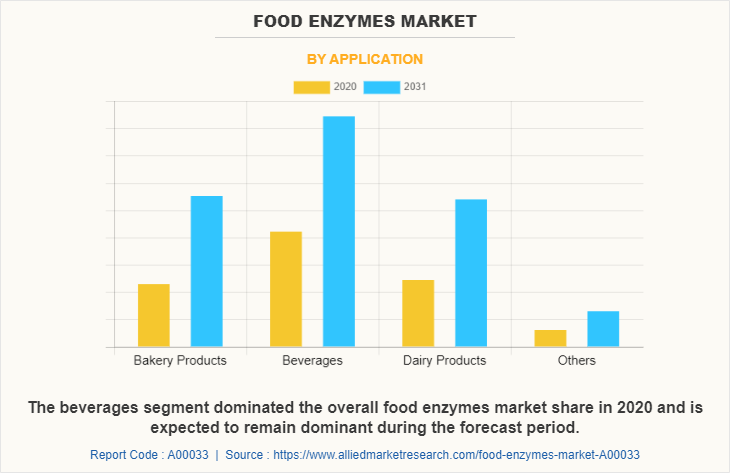
Enzymes are biocatalysts that accelerate various biochemical reactions. Microorganisms are the most favored source of food enzymes. Development of fermentation techniques for the production of microbial enzymes aid in providing extensive supply of enzymes. Bacteria, fungi, and yeast are used extensively for the biosynthesis of various enzymes that are further used in several commercial applications.
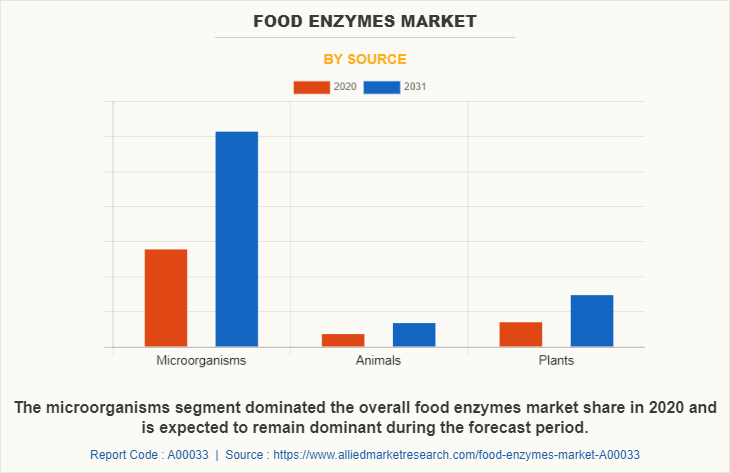
The global food enzymes industry is segmented based on type, application, and material. Based on type, the food enzyme market is classified into carbohydrase, lipase, protease, and others. Based on application, the market is divided into bakery products, beverages, dairy products, and others. Based on source, the market is analyzed across microorganisms, plants, and animals. Based on region, the market is studied across North America, Europe, Asia-Pacific, and LAMEA.
Some of the key players in the market are Associated British Foods Plc. (ABF), Advanced Enzyme Technologies, Amano Enzyme Co., Ltd., BASF, Chr. Hansen Holding A/S, DowDuPont, Kerry Group PLC, Novozymes, Royal DSM N.V., and Aum Enzymes.
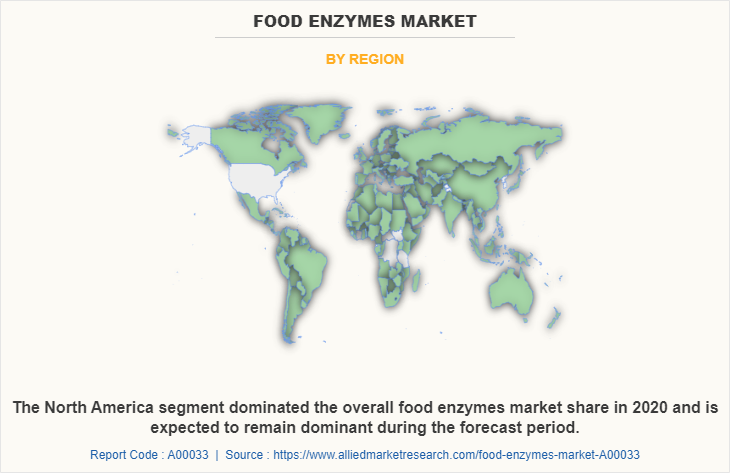
North America is the leading consumer of food enzymes followed by Europe and Asia-Pacific. However, Asia-Pacific is poised to gain significant market share in the global food enzyme market during the forecast period. It is imperative to note that immobilized enzyme technology for food application have gained high traction in the last few years. Immobilized enzyme technology enhances characteristics of food enzymes such as slow reaction rate limited shelf life and operational stability. Also trends of clean labelling has gained wide attraction across the world. Leading players are now venturing into this segment to cater to the growth in demand from health-conscious consumers.
Key Benefits For Stakeholders
- This report provides a quantitative analysis of the food enzymes market size segments, current trends, estimations, and dynamics of the food enzymes market analysis from 2020 to 2031 to identify the prevailing food enzymes market opportunities.
- The market research is offered along with information related to key drivers, restraints, and opportunities.
- Porter's five forces analysis highlights the potency of buyers and suppliers to enable stakeholders make profit-oriented business decisions and strengthen their supplier-buyer network.
- In-depth analysis of the food enzymes market segmentation assists to determine the prevailing market opportunities.
- Major countries in each region are mapped according to their revenue contribution to the global market.
- Market player positioning facilitates benchmarking and provides a clear understanding of the present position of the market players.
- The report includes the analysis of the regional as well as global food enzymes market trends, key players, market segments, application areas, and market growth strategies.
Food Enzymes Market Report Highlights
| Aspects | Details |
| By Type |
|
| By Application |
|
| By Source |
|
| By Region |
|
| Key Market Players | Kerry Group PLC, Chr. Hansen Holding A/S, Aum Enzymes, DowDuPont, Royal DSM N.V, Associated British Foods Plc., Advanced Enzyme Technologies, Novozymes, BASF, Amano Enzyme Co., Ltd |
Analyst Review
Analyst Review: Food Enzymes Market
The food enzymes market remained one of the few bright spots in an otherwise troubled global economy due to the global COVID-19 pandemic crisis. Food enzymes are frequently employed in food processing because of their numerous benefits, which include texture, flavor, and smell enhancement, preservation, coagulation, and tenderization. In most cases, food enzymes are created through the fermentation process. Food enzymes are commercially produced using both, fed-batch and continuous fermentation techniques globally. However, food enzymes can also be obtained from animals and plants. It's worth noting that millennial are more concerned than previous generations about food transparency. They want food that contains few or no artificial ingredients or synthetic chemicals. They also want food that hasn't been processed as much. As a result, top manufacturers are focusing on producing clean label items to meet millennials' growing preferences. The market is expected to experience growth during the forecast period owing to expansion of the food & beverage industry, diversification in extraction process, and rise in trend of cold–adapted enzymes. At the same time, the sector is facing challenges driven by certain food enzyme allergies, limited shelf life, and high sensitivity of food enzymes toward temperature and pH.
Engaged stakeholders in the industry include spending significant time and resources to create new applications for food enzymes and patenting their innovations. Furthermore, leading players are converging toward clean label food enzymes to maintain the reputation by producing safe and high-quality natural products. Food enzymes’ specificity, stability, and overall application potential have all improved as a result of advances in protein and genetic engineering. Food enzymes find application on plethora of platforms, such as starch modification, sweetener production, sugar processing, baking, flour supplementation, dough conditioning, cheese making, brewing, flavor enhancement, meat tenderizing, and juice processing.
The upcoming trends in food enzymes market are expansion in F&B industry, along with development in extraction technology.
The beverages segment was the highest revenue contributor to the market, with $844.8 million in 2020, and is estimated to reach $1,689.7 million by 2031, with a CAGR of 5.4%. The dairy products segment is estimated to reach $1,076.6 million by 2031, at a significant CAGR of 6.4% during the forecast period.
North America is the leading consumer of food enzymes followed by Europe and Asia-Pacific. However, Asia-Pacific is poised to gain significant market share in the global food enzyme market during the forecast period.
The global Food Enzymes market was valued at $1,906.7 million in 2020, and is projected to reach $4,124.7 million by 2031, registering a CAGR of 6.2% from 2022 to 2031.
Key players profiled in the report include Associated British Foods Plc. (ABF), Advanced Enzyme Technologies, Amano Enzyme Co., Ltd., BASF, Chr. Hansen Holding A/S, DowDuPont, Kerry Group PLC, Novozymes, Royal DSM N.V., and Aum Enzymes.
The global Food Enzymes market registered a CAGR of 6.2% from 2022 to 2031. The carbohydrase segment was the highest revenue contributor to the market, with $1,199.9 million in 2020, and is estimated to reach $2,592.8 million by 2031, with a CAGR of 6.1%. The
The forecast period of Food Enzymes report is from 2022 to 2031. The global food enzymes market is segmented based on type, application, source, and region. Based on type, the food enzyme market is segmented into carbohydrase, lipase, protease, others. Based on application, the market is divided into bakery products, beverages, dairy products, and others. Based on source, the market is analyzed across microorganisms, plants, and animals. Based on region, the market is studied across North America, Europe, Asia-Pacific, and LAMEA.
The global food enzymes market is segmented based on type, application, source, and region. Based on type, the food enzyme market is segmented into carbohydrase, lipase, protease, others. Based on application, the market is divided into bakery products, beverages, dairy products, and others. Based on source, the market is analyzed across microorganisms, plants, and animals. Based on region, the market is studied across North America, Europe, Asia-Pacific, and LAMEA.
Loading Table Of Content...


